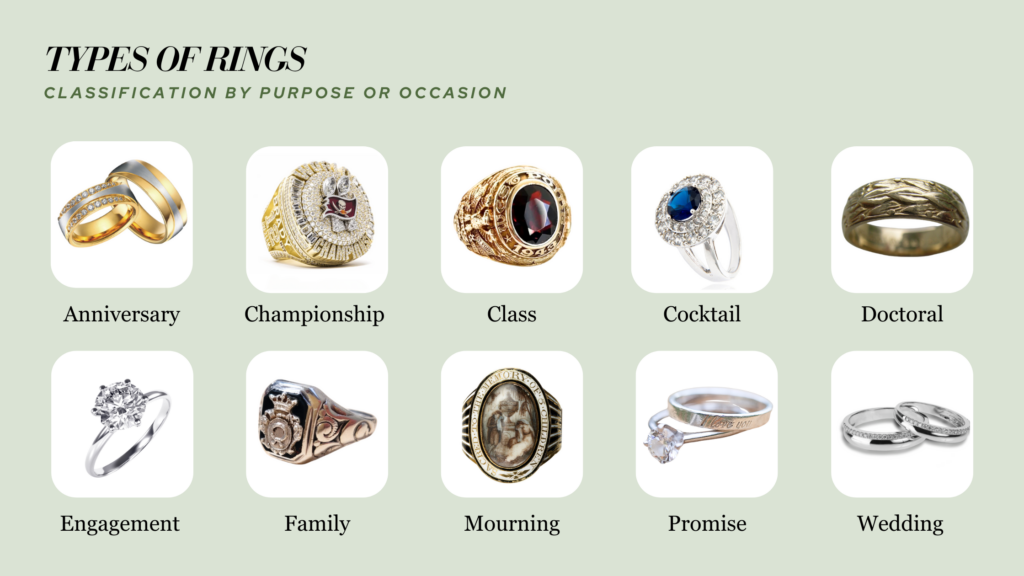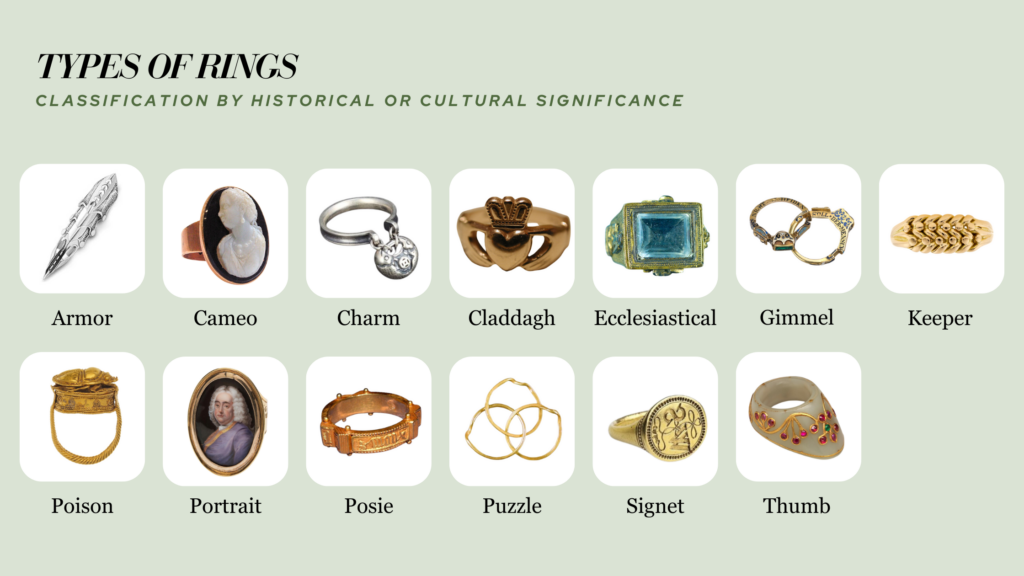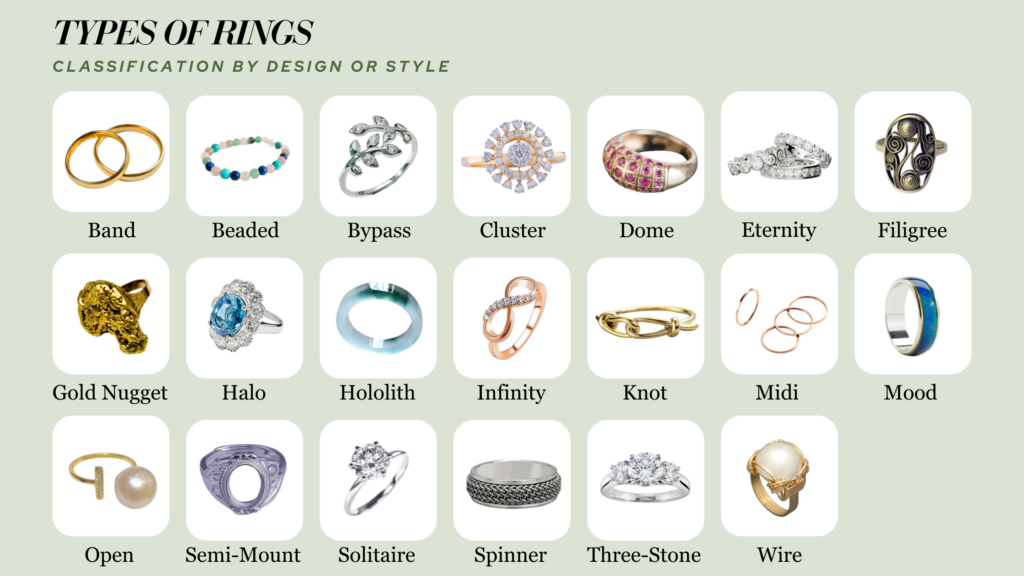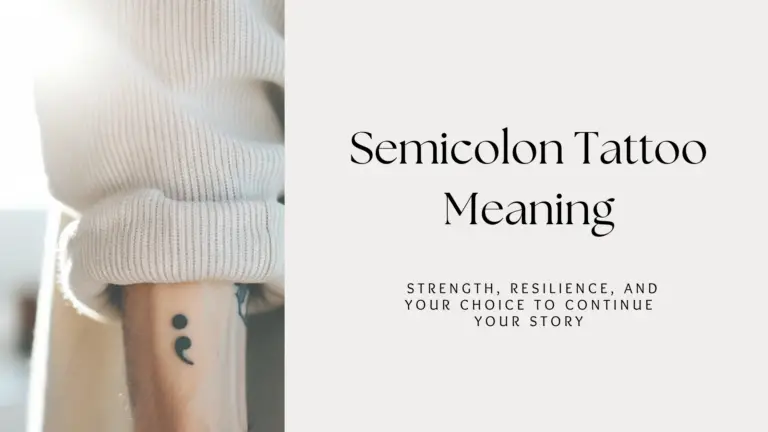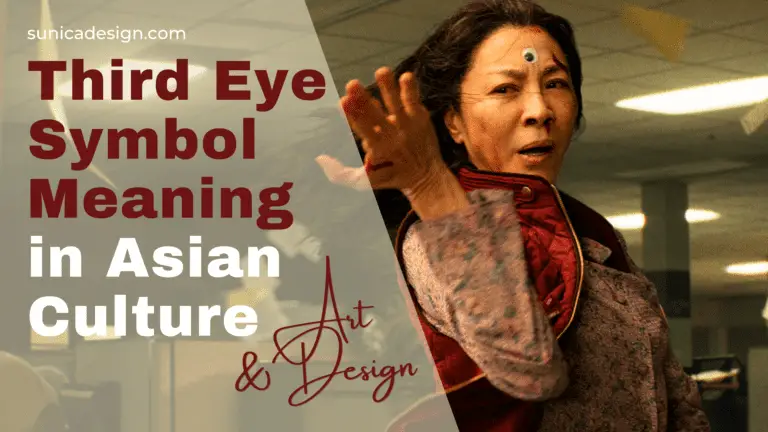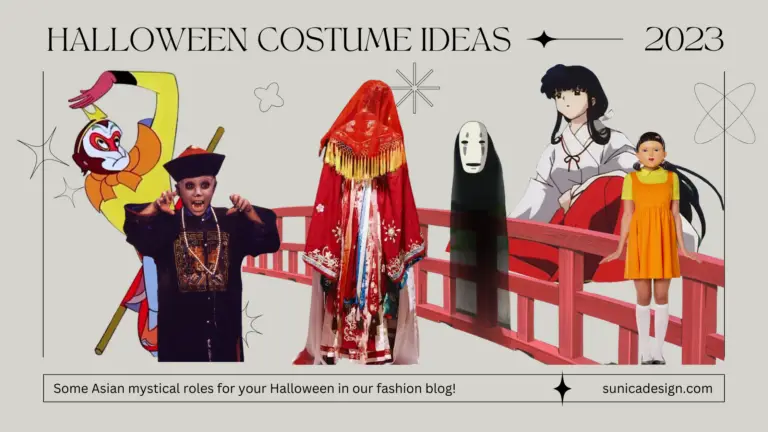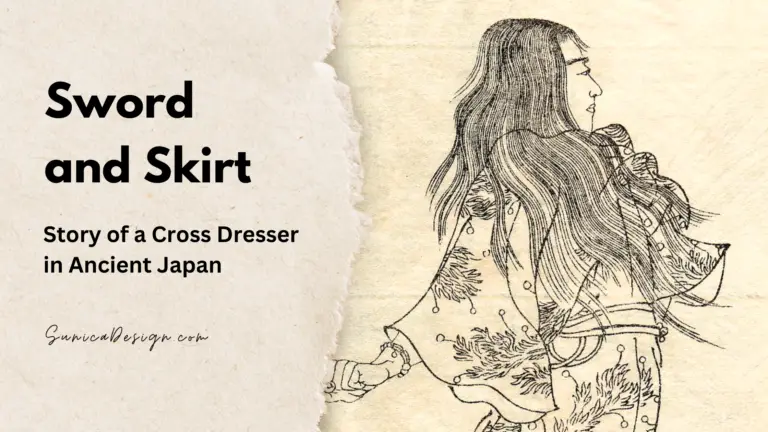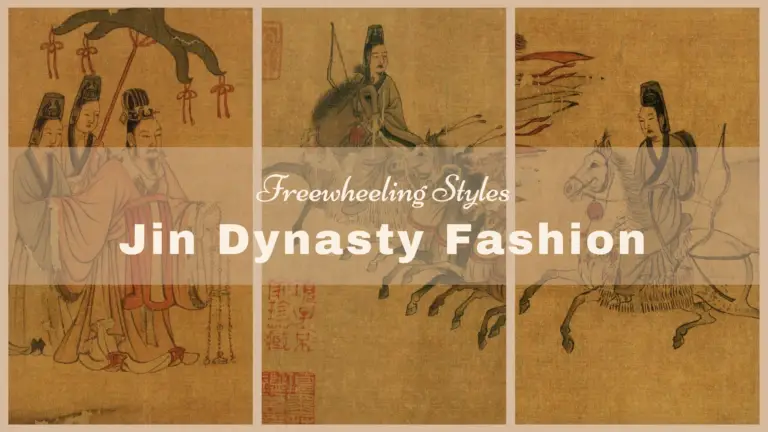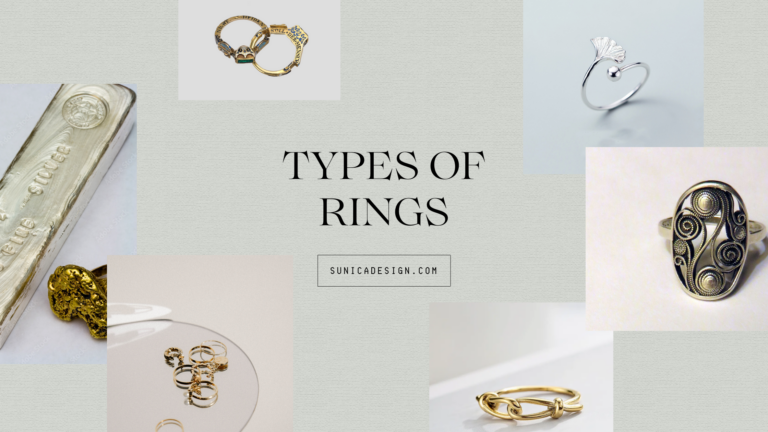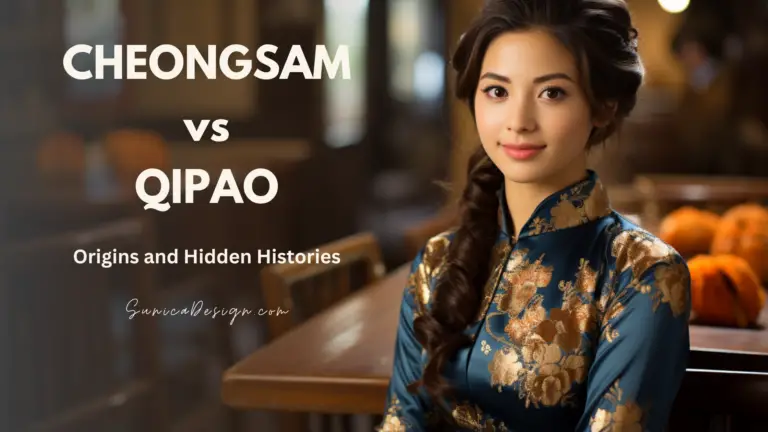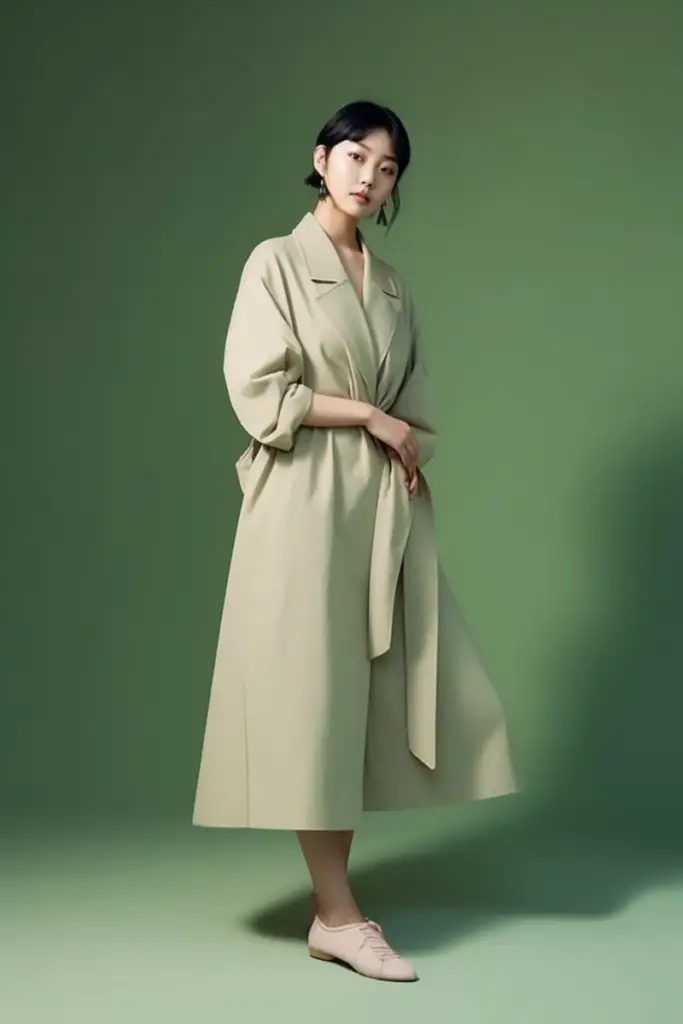Rings hold a special place in the world of jewelry. They symbolize love, represent personal milestones, and express individual styles. In this article, we’re set to explore different types of rings. Our exploration will be organized into distinct categories, including purpose, historical significance, and designs. This structure aims to help us dive deeper into each type, understanding its roots and relevance.
Classification By Purpose or Occasion
Anniversary Rings
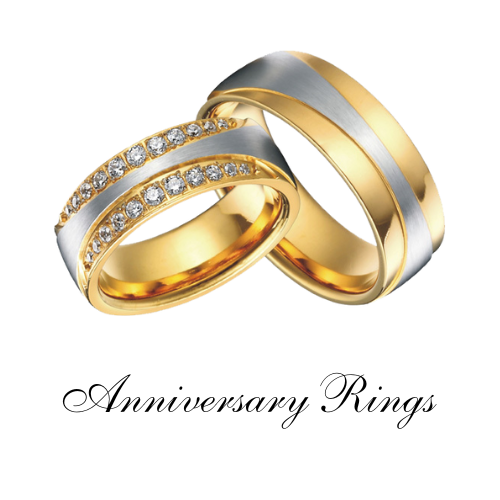 Anniversary rings, as a type of ring, embody the ongoing love in a marriage. Often given to celebrate a significant wedding anniversary, they’re a way to renew vows or to simply say, “I still choose you.” Unlike engagement and wedding rings, anniversary rings don’t adhere to a specific tradition. This freedom allows for a wide range of styles and designs.
Anniversary rings, as a type of ring, embody the ongoing love in a marriage. Often given to celebrate a significant wedding anniversary, they’re a way to renew vows or to simply say, “I still choose you.” Unlike engagement and wedding rings, anniversary rings don’t adhere to a specific tradition. This freedom allows for a wide range of styles and designs.
These rings’ popularity surged in the 20th century. Couples buy these special rings to mark their milestone anniversaries. The 25th and 50th anniversaries, known as the silver and golden jubilees, are particularly popular occasions for such gifts.
Styles vary widely, reflecting personal stories and tastes. They can be simple bands, eternity styles, or feature multiple stones. Diamonds are conventional, but colored gemstones like sapphires or rubies offer personalization. Some opt for birthstones, adding sentimental value.
Championship Rings
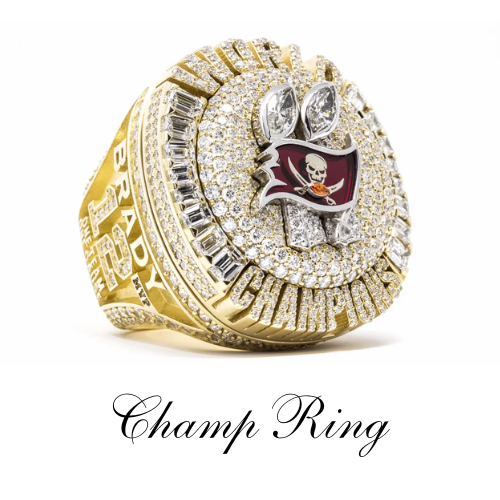 Championship rings are symbols of victory and achievement in North America. They are awarded to athletes and team members who win a significant sports championship as treasured mementos that commemorate hard work, teamwork, and triumph.
Championship rings are symbols of victory and achievement in North America. They are awarded to athletes and team members who win a significant sports championship as treasured mementos that commemorate hard work, teamwork, and triumph.
Championship rings typically showcase the team’s logo and the championship year, and often include the recipient’s name. They are usually adorned with the team’s colors and are often embellished with diamonds or other precious stones, making them quite striking and valuable.
Initially, in the early 20th century, athletes were awarded items like pocket watches, tie clips, or cufflinks to commemorate successful seasons. The first instance of championship rings, as we recognize them today, was in the 1922 World Series, where the New York Giants received rings for their victory over the New York Yankees. However, it wasn’t until the 1930s that championship rings became a standard tradition for commemorating sports victories.
Once awarded, the usage of these rings varies. While some athletes proudly wear them, others may keep them in a safe or display them as part of a collection. They’re often too large and ornate for everyday wear. Due to their value and significance, they’re also occasionally sold, especially by players or staff in financial need.
Class Rings
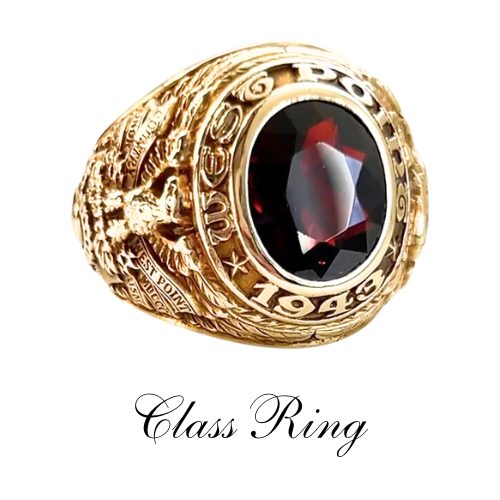 Class rings, also known as graduation rings, are a long-standing tradition in the United States. These rings symbolize achievement and camaraderie, commemorating the completion of an academic journey from high school, college, or university.
Class rings, also known as graduation rings, are a long-standing tradition in the United States. These rings symbolize achievement and camaraderie, commemorating the completion of an academic journey from high school, college, or university.
The tradition of class rings can be traced back to 1835 at the United States Military Academy at West Point. Initially, these rings were a symbol of unity among cadets, embodying the values and pride associated with graduating from such a prestigious institution. Over time, the tradition spread to other educational institutions, including Harvard, Yale, and Princeton, and eventually became a common symbol of pride and accomplishment throughout high schools and universities in the United States and Canada.
Today, students can personalize their class rings with various metals, stone colors, and individual details like their name, graduation year, and activities or interests they pursued during their schooling. This level of customization makes each ring a unique representation of the wearer’s academic and personal journey.
Cocktail Rings
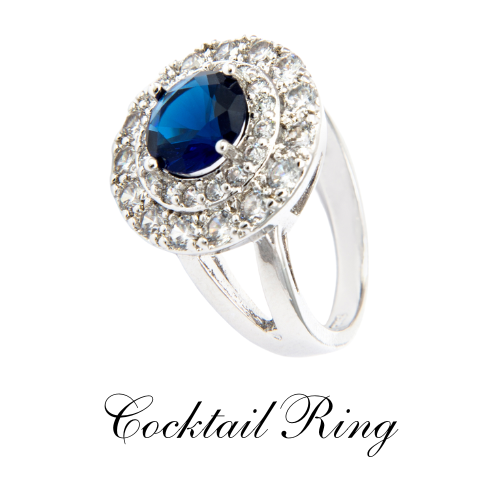 Cocktail rings, also called statement rings, are renowned for their striking and bold designs. They often feature very large center stones accentuated by pavé diamonds or other gemstones. Originally, these rings were designed to be dramatic and eye-catching. Today, any ring that makes a strong statement is typically referred to as a cocktail ring.
Cocktail rings, also called statement rings, are renowned for their striking and bold designs. They often feature very large center stones accentuated by pavé diamonds or other gemstones. Originally, these rings were designed to be dramatic and eye-catching. Today, any ring that makes a strong statement is typically referred to as a cocktail ring.
The history of cocktail rings dates back to the American Prohibition era of the 1920s. It was a time when alcohol was banned, leading to the rise of illegal drinking parties, including cocktail parties. The 1920s marked significant social changes, especially for women. They embraced newfound freedoms, including the right to vote, flapper fashion with short hair and skirts, and the enjoyment of smoking and drinking. Women were expressing their independence, and cocktail rings were a perfect symbol of this new freedom. They flaunted their cocktail rings as they sipped their forbidden drinks, making a statement of both fashion and defiance.
For most people, cocktail rings are often worn on the right hand, specifically on the ring finger or the middle finger, so they can show their statement rings when holding up wine glasses. The choice between the ring finger and the middle finger usually depends on the ring’s size and design, as well as personal comfort. Larger, ornate cocktail rings might be more balanced and comfortable on the middle finger. The middle finger provides a larger canvas for the ring, showcasing its design more prominently.
Doctoral Rings
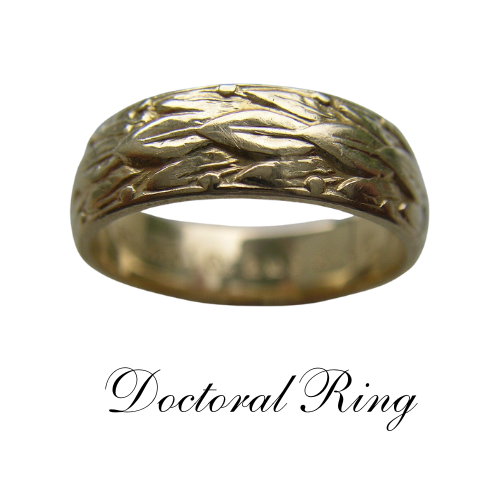 Doctoral rings symbolize the achievement of a doctoral degree in northern Europe. These rings are often worn by graduates as a symbol of their scholarly journey and dedication to their field of study.
Doctoral rings symbolize the achievement of a doctoral degree in northern Europe. These rings are often worn by graduates as a symbol of their scholarly journey and dedication to their field of study.
In some countries, particularly in parts of Europe like Scandinavia, Sweden, and Germany, doctoral rings are an established part of academic regalia. They are often presented during a formal ceremony upon the completion of a doctoral degree as a symbol of academic achievement.
The design of a doctoral ring often includes specific insignia or emblems representing the academic institution from which the doctorate was earned. Additionally, they may be engraved with the graduate’s field of study or year of graduation. The design of these rings is typically simple and elegant, reflecting the prestige and seriousness of academia.
Engagement Rings
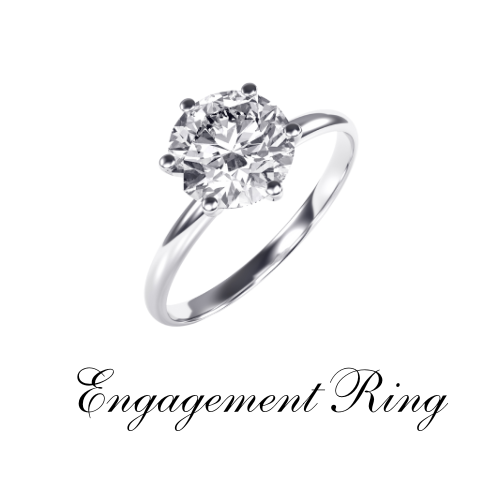 Engagement rings are notable symbols of love and commitment and have a story that dates back centuries. In Ancient Rome, rings made from various materials, like flint, copper, or gold, were exchanged. The Romans believed a “vein of love” ran from the fourth finger of the left hand to the heart. This belief started the custom of placing rings on that finger. The rings also symbolized a form of contract between couples.
Engagement rings are notable symbols of love and commitment and have a story that dates back centuries. In Ancient Rome, rings made from various materials, like flint, copper, or gold, were exchanged. The Romans believed a “vein of love” ran from the fourth finger of the left hand to the heart. This belief started the custom of placing rings on that finger. The rings also symbolized a form of contract between couples.
In the 8th century, Pope Nicolas I introduced the concept of a ring as a symbol of intention to marry. This tradition spanned through the Middle Ages, with ruby and sapphire rings being popular. The first recorded diamond engagement ring appeared in 1477 when Archduke Maximilian of Austria proposed to Mary of Burgundy.
Diamond engagement rings gained popularity in the 18th and 19th centuries following diamond discoveries worldwide. The Industrial Revolution led to advancements in diamond cutting and setting, making diamonds more accessible. In the 20th century, the famous De Beers marketing campaign in 1938 dramatically revived the allure of diamond engagement rings. Their slogan, “A diamond is forever,” became synonymous with engagement rings, implying that diamonds were the ultimate symbol of eternal love. This successful campaign shifted the entire culture around engagement rings, making diamond rings a mainstay.
Family Rings
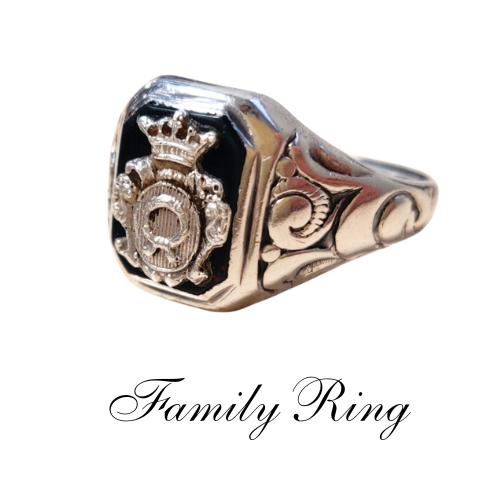 Family rings are a special type of ring that represents the bond and connection within a family. Typically, these rings incorporate elements that symbolize family members, such as engraved names and birthdates. The design of family rings can vary greatly, allowing for the inclusion of many family members, and they can be crafted from various metals and materials.
Family rings are a special type of ring that represents the bond and connection within a family. Typically, these rings incorporate elements that symbolize family members, such as engraved names and birthdates. The design of family rings can vary greatly, allowing for the inclusion of many family members, and they can be crafted from various metals and materials.
The origins of family rings are somewhat uncertain, with different theories about their inception. Some believe they have ancient roots, while others argue they became popular around the 1950s. One theory suggests they originated from a jeweler’s innovation to include small stones in rings, leading to a trend of incorporating family members’ birthstones. Another theory proposes that family rings were created to commemorate significant events like a child’s marriage, incorporating the birthstones of both biological and wedlock children.
Family rings can represent any family member, including parents, siblings, cousins, aunts, uncles, and grandparents. These rings are symbols of family pride and love, often passed down as heirlooms, representing the legacy and memories of a family.
The decision of who inherits a family ring can be based on various factors, such as interest and appreciation for the heirloom, practical considerations like ring size, and the relationship between the giver and potential recipients. The ring can be passed down at life milestones or specified in wills.
Mourning Rings
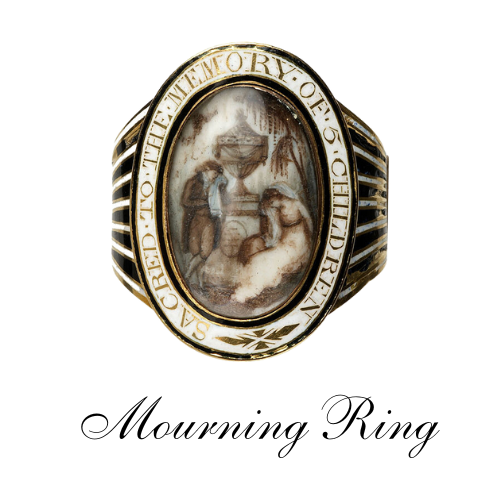 Mourning rings hold a unique place in the spectrum of types of rings. They serve as a memorial to a deceased loved one. Traditionally, these rings are worn as a symbol of remembrance and grief. They often include inscriptions, images, or symbols that are significant to the person being memorialized.
Mourning rings hold a unique place in the spectrum of types of rings. They serve as a memorial to a deceased loved one. Traditionally, these rings are worn as a symbol of remembrance and grief. They often include inscriptions, images, or symbols that are significant to the person being memorialized.
The history of mourning rings can be traced back to at least the 14th century, but they became particularly prominent during the Victorian era. This period saw a heightened emphasis on mourning customs and practices, influenced by Queen Victoria’s public mourning of her husband, Prince Albert. During this time, mourning rings often contained the hair of the deceased, intricately woven into the design, or were made with jet, a black fossilized wood commonly used in mourning jewelry.
The designs of mourning rings have varied over the centuries. In the Georgian era, they often featured skulls, coffins, and other memento mori symbols. Later, during the Victorian era, the designs became more intricate and sentimental, often including images of weeping willows, urns, clasped hands, and the deceased’s hair or initials. Some rings also displayed phrases like “In Memory Of” to convey their purpose explicitly.
Promise Rings
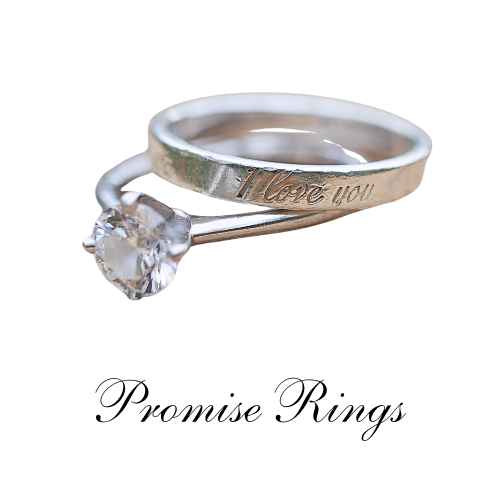 Promise rings are often given before an engagement. Their purpose is to signify a strong bond and a promise of future engagement.
Promise rings are often given before an engagement. Their purpose is to signify a strong bond and a promise of future engagement.
Unlike engagement rings, promise rings don’t signify a commitment to marriage. Instead, they represent devotion and a deep connection. They’re typically simpler and less expensive than engagement rings. The design often includes heart symbols, infinity symbols, or small stones. Some prefer engravings with meaningful messages or dates. The choice depends on personal style and the promise’s significance.
In terms of wearing promise rings, there’s flexibility. Some wear them on the ring finger of the left hand. Others choose a different finger or even the right hand. This choice also sets them apart from traditional engagement rings.
The history of promise rings dates back to hundreds of years ago. In the 16th century, posy rings (also called “posie rings“) with romantic inscriptions became popular in England. There were poetic verses engraved on their inner surfaces. During the 20th century, these rings evolved, and promise rings appeared to express love and fidelity.
Wedding Rings
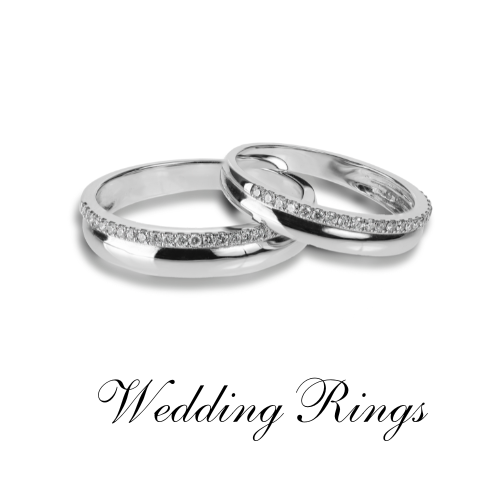 Wedding rings symbolize love, commitment, and unity. They are a type of ring that is often mistaken for engagement rings. They differ from engagement rings in their symbolism and use. Engagement rings typically signify a promise of marriage and are given at the proposal. However, wedding rings symbolize the actual bond of marriage and are exchanged during the wedding ceremony.
Wedding rings symbolize love, commitment, and unity. They are a type of ring that is often mistaken for engagement rings. They differ from engagement rings in their symbolism and use. Engagement rings typically signify a promise of marriage and are given at the proposal. However, wedding rings symbolize the actual bond of marriage and are exchanged during the wedding ceremony.
While engagement rings are typically more ornate and often include a large diamond or other gemstone, wedding rings are usually more understated. The wedding ring is often a plain band made of precious metals like gold or platinum. People usually stack it with the engagement ring on the same finger.
Modern wedding rings come in various styles and materials. Gold, platinum, and titanium are popular choices. Rings can feature diamonds or other gemstones running continuously around the band (eternity rings) or a center stone surrounded by smaller stones (halo rings). Customization, such as engraving and personalized designs, adds a unique touch.
Classification By Historical or Cultural Significance
Armor Rings
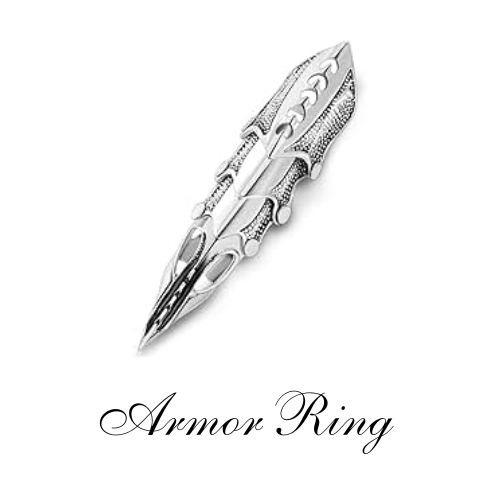 Armor rings stand out in the diverse types of rings for their bold and distinctive design. These rings span multiple joints of the finger, resembling the look of medieval armor, hence their name.
Armor rings stand out in the diverse types of rings for their bold and distinctive design. These rings span multiple joints of the finger, resembling the look of medieval armor, hence their name.
The greatest features of armor rings are their coverage and design. They can range from sleek, metallic pieces that cover just a couple of finger joints to more elaborate designs that extend over the entire finger. These rings often feature intricate details like filigree work, embedded gemstones, or thematic elements. Some designers also incorporate elements of fantasy or medieval themes into their designs, adding to the ring’s dramatic flair. The material used can vary as well, from sterling silver and gold to more affordable alloys.
Originally, armor rings were designed to emulate the protective gear worn by knights. They were meant to cover the fingers and knuckles. Today, they are used more as a fashion statement rather than for protection. Their appeal lies in their ability to make a bold statement and add an edge to any outfit. In the fashion world, they have emerged as a trend in Gothic and alternative styles.
Cameo Rings
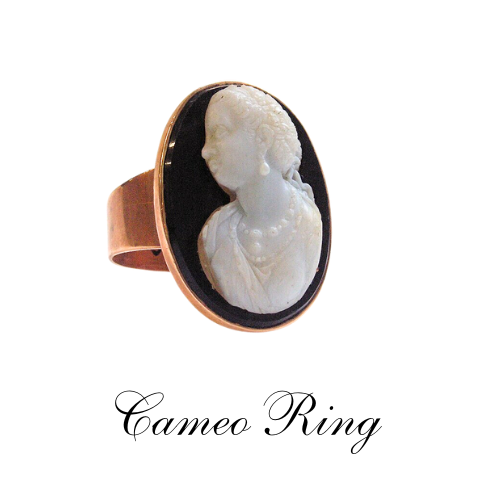 Cameo rings feature a raised image or scene carved against a contrasting background. Historically, cameos have been crafted from various materials, including shell, stone, and glass, with the top layer protruding to create a multi-dimensional artwork.
Cameo rings feature a raised image or scene carved against a contrasting background. Historically, cameos have been crafted from various materials, including shell, stone, and glass, with the top layer protruding to create a multi-dimensional artwork.
The earliest cameos date back to ancient civilizations like Egypt, Greece, and Rome. These early cameos often depicted religious and mythological themes during the Roman Empire. The Renaissance and Elizabethan periods were instrumental in the evolution of cameo art, with elite women collecting cameos as signs of cultural status. Pope Paul II’s fondness for cameos, particularly those worn on rings, is a notable historical anecdote.
Cameo rings gained immense popularity during the 19th century, influenced by royal figures like Queen Victoria and Napoleon Bonaparte. Queen Victoria’s preference for shelled cameos played a significant role in popularizing this style. Cameos made from petrified lava also emerged during this time, becoming souvenirs for travelers and symbols of status and wealth.
In terms of design, cameo rings vary widely, with some featuring simple bezel settings and others adorned with intricate metalwork. The artistry of the carving is a critical aspect of a cameo’s value, with the finest examples displaying graceful, detailed, and smooth-flowing lines.
Charm Rings
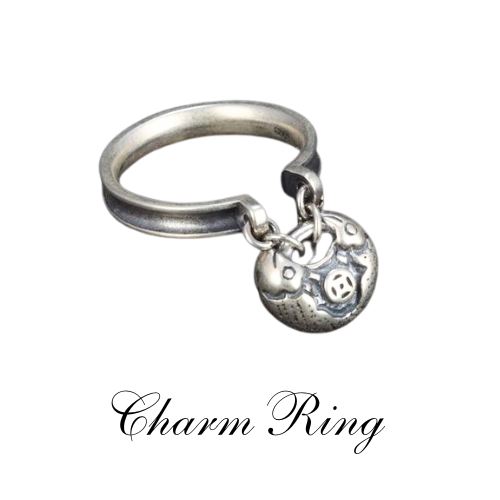 Charm rings often have small trinkets or charms attached to the ring.
Charm rings often have small trinkets or charms attached to the ring.
The concept of charm jewelry, which includes charm rings, has a long and rich history, dating back to ancient civilizations. In ancient Egypt, for instance, charms were used as amulets or talismans, believed to ward off evil and bring good luck. These early charms often took the shape of animals or symbols with significant meanings. The Romans also used charm rings, with early Christians wearing fish charms to identify themselves to other Christians.
In the Victorian era, charm jewelry gained popularity as a way to showcase personal interests and commemorate important life events. Queen Victoria herself was known for her charm bracelets, which influenced jewelry trends of the time. These bracelets often held lockets with portraits or locks of hair, setting the stage for modern charm bracelets and rings.
Modern charm rings come in various designs, with charms ranging from simple decorative elements to intricate symbols representing personal milestones, interests, or relationships. The rings themselves can be made of various materials, including gold, silver, and other metals, and may have additional decorative elements like gemstones or engravings.
Claddagh Rings
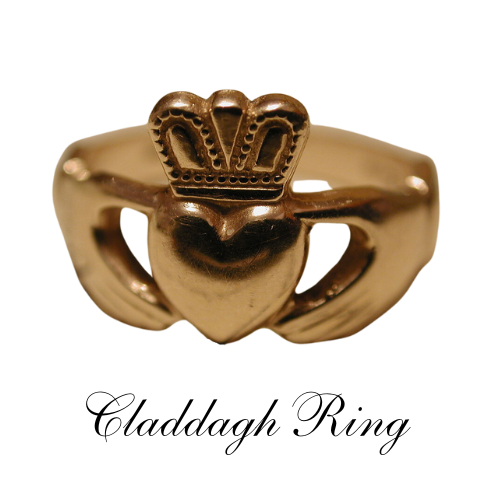 Claddagh rings are a type of ring rich in Irish tradition and symbolism. They feature two hands clasping a heart, topped with a crown. This iconic design represents love (the heart), friendship (the hands), and loyalty (the crown). Some designs incorporate gemstones into the heart or crown, adding an extra layer of beauty and personalization.
Claddagh rings are a type of ring rich in Irish tradition and symbolism. They feature two hands clasping a heart, topped with a crown. This iconic design represents love (the heart), friendship (the hands), and loyalty (the crown). Some designs incorporate gemstones into the heart or crown, adding an extra layer of beauty and personalization.
The history of the Claddagh ring traces back to a small fishing village named Claddagh in Galway, Ireland, in the 17th century. One popular story involves a fisherman, Richard Joyce, who was captured and enslaved. While in captivity, he crafted a ring for his beloved back in Claddagh, vowing to return to her. Upon his release, he returned to the village, found his love waiting, and presented her with the ring. This romantic tale underpins the Claddagh ring’s enduring symbol of devoted love and faithfulness.
How a Claddagh ring is worn carries significant meaning and can convey the wearer’s relationship status. Worn on the right hand with the heart pointing outwards, it suggests the wearer’s heart is unoccupied, and this person is single. If the heart points inward on the right hand, it signifies the wearer is in a relationship. When the heart points outward on the left hand, the wearer is engaged and not yet married. When the heart points inward on the left hand, it symbolizes marriage, showing the wearer’s heart is forever locked to another.
Ecclesiastical Rings
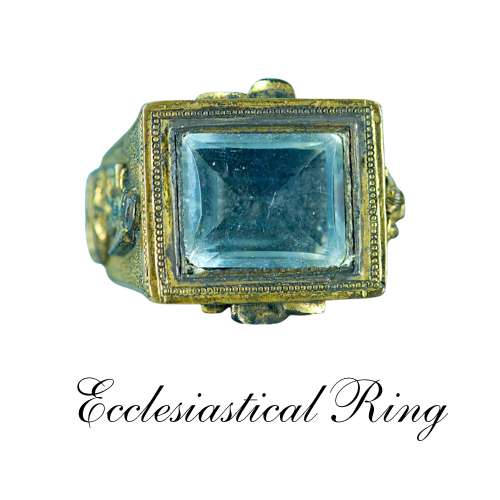 Ecclesiastical rings are a type of rings deeply rooted in religious and spiritual traditions. Clergy or religious figures primarily wear them as a symbol of their sacred commitment and authority.
Ecclesiastical rings are a type of rings deeply rooted in religious and spiritual traditions. Clergy or religious figures primarily wear them as a symbol of their sacred commitment and authority.
The most notable feature of ecclesiastical rings is their symbolic nature. They often bear designs that reflect religious motifs, such as crosses, saints, or inscriptions of religious significance. These rings carry profound spiritual meaning and are often used in religious ceremonies or functions.
The design of ecclesiastical rings varies depending on the denomination and the rank of the clergy member. In the Catholic Church, for example, bishops typically wear a ring known as the “episcopal ring,” usually set with an amethyst. This ring symbolizes their commitment to the church and their role as a spiritual shepherd. Popes also have a special ring known as the “Fisherman’s Ring,” which historically was used to seal official documents.
Tracing the history of ecclesiastical rings, we find their origins in the early Christian church. Initially, these rings were simple in design, but as the church’s influence grew, so did the intricacy of the rings. By the Middle Ages, ecclesiastical rings had become more elaborate, often adorned with precious stones and intricate engravings.
The ecclesiastical ring is often worn on the ring finger of the right hand. It symbolizes the wearer’s marriage to the church and devotion to their religious duties. The wearing of the ring is often associated with oaths and vows in many religious traditions.
Gimmel Rings
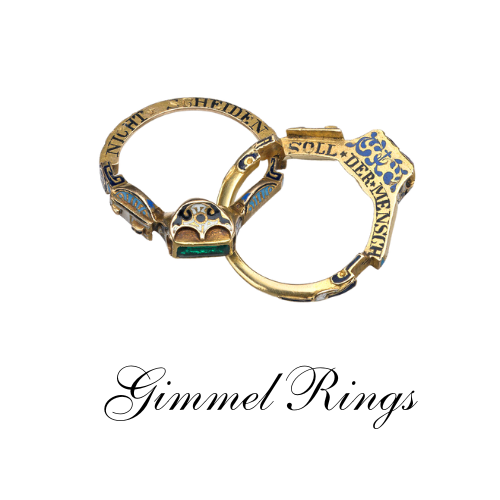 Gimmel rings were born and became popular during the Renaissance period. They are particularly renowned for their construction from two or three interlocking bands. The term “gimmel” derives from “gemellu,” the Latin word for twin, reflecting the ring’s intertwined design.
Gimmel rings were born and became popular during the Renaissance period. They are particularly renowned for their construction from two or three interlocking bands. The term “gimmel” derives from “gemellu,” the Latin word for twin, reflecting the ring’s intertwined design.
The rings’ mechanism allows their multiple bands to unite seamlessly. The design of gimmel rings varies, ranging from simple and elegant to more ornate styles adorned with engravings, gemstones, and motifs. Common themes include hands clasping or hearts.
Traditionally used in betrothals and marriages, gimmel rings embody the union of two individuals. Sometimes, there would be a third band for a witness to the couple’s commitment. This person would hold onto the third part of the ring until the marriage was solemnized. And then, the bands would be reunited to form one ring for the bride.
Keeper Rings
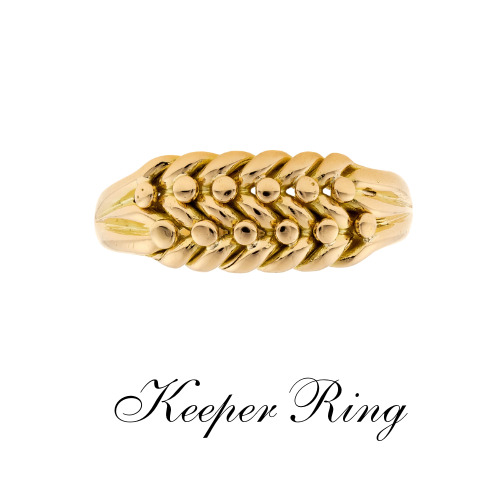 Originating in the Middle Ages, keeper rings were made from gold with distinctive all-over chased patterning. These rings stood out for their considerable weight and intricate design, indicating the wearer’s wealth.
Originating in the Middle Ages, keeper rings were made from gold with distinctive all-over chased patterning. These rings stood out for their considerable weight and intricate design, indicating the wearer’s wealth.
In historical contexts, keeper rings were often worn alongside wedding bands to prevent other rings from sliding off. They were also used as promise rings, signifying an outward declaration of coming engagement. Beyond their symbolic significance, keeper rings were also practical. In times of financial crisis, these substantial gold rings could be pawned or sold, offering a layer of financial security to the bearer. This feature made them a form of “portable wealth.”
The patterns etched by hand on keeper rings range from elaborate floral motifs to geometric shapes. These textured and visually striking designs need meticulous crafts. The crafting process required exceptional skill and precision.
Poison Rings
 Poison rings, or pillbox rings, feature a secret compartment, traditionally under a hinged cover or within the bezel itself. Historically, this compartment could have held poison, pills, or another substance.
Poison rings, or pillbox rings, feature a secret compartment, traditionally under a hinged cover or within the bezel itself. Historically, this compartment could have held poison, pills, or another substance.
The concept of poison rings originated in ancient India and the Far East and eventually made its way to Europe around the 16th century. During the Middle Ages, the term “poison ring” emerged, fueled by rumors that the aristocracy used these rings to discreetly slip poison into an enemy’s food or drink. However, the actual use of these rings for murder was not common because disguising the taste of poison and making a dose powerful enough to be fatal yet small enough to fit in a ring was extremely difficult.
Beyond their more nefarious uses, poison rings also had benign purposes. In the Middle Ages, they often contained relics of saints, thought to protect the wearer from harm. During the Renaissance, they were used by the aristocracy to hold cologne, locks of hair, and portraits of loved ones.
The design of poison rings varied, but they typically featured a large stone to conceal the compartment. This design allowed the hidden cavity to be undetected.
Portrait Rings
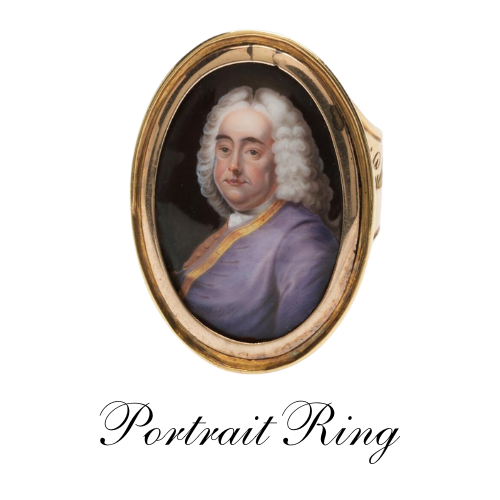 Portrait rings are a historically rich type of ring known for miniature portraits as their central design element. These rings have been around since the 17th century and became popular during the 18th and 19th centuries, often falling under the Georgian style.
Portrait rings are a historically rich type of ring known for miniature portraits as their central design element. These rings have been around since the 17th century and became popular during the 18th and 19th centuries, often falling under the Georgian style.
The primary use of portrait rings was personal adornments. They often depict loved ones, royalty, or popular political figures. The miniature portraits were often created by watercolors on small canvases of ivory or vellum. Some were made with enamel on metal, a technique that evolved from the Limoges style. Renowned artists were sometimes commissioned to create these miniatures. The artwork was usually preserved under a piece of clear flat rock crystal or, in some special cases, under portrait diamonds — totally flat gems.
The decline in the popularity of miniature portrait jewelry coincided with the rise of photography. Although they are rare, good-quality portrait rings can still be found today.
Posie Rings
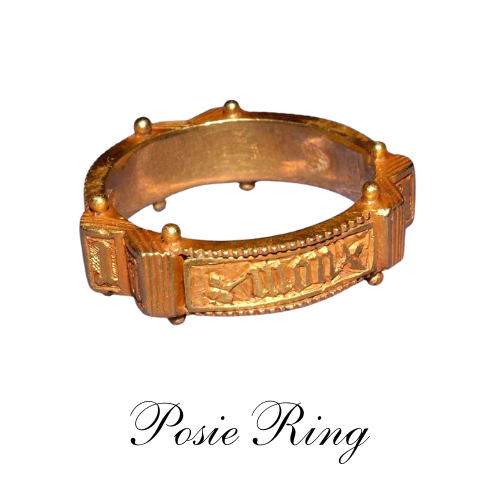 As we discussed in the “Promise Rings” section, posie rings are a type of ring known for their romantic inscriptions. They were especially popular in England and France during the 15th to 17th centuries.
As we discussed in the “Promise Rings” section, posie rings are a type of ring known for their romantic inscriptions. They were especially popular in England and France during the 15th to 17th centuries.
The defining feature of posie rings is the short poetic inscription on their surface, often expressing love, devotion, or friendship. These inscriptions were usually engraved on the inner surface of the ring. The language of these inscriptions varied, with early examples often in Norman French, and later in French, Latin, and Old English. The phrases were typically written in scripts such as Lombardic until about 1350, and later in Gothic script.
Today, posie rings are not as commonly designed or used as once, but their concept lives on in modern engraved rings. Some contemporary jewelry also features inscriptions on the inner sides of shanks, continuing the tradition of meaningful messages.
Puzzle Rings
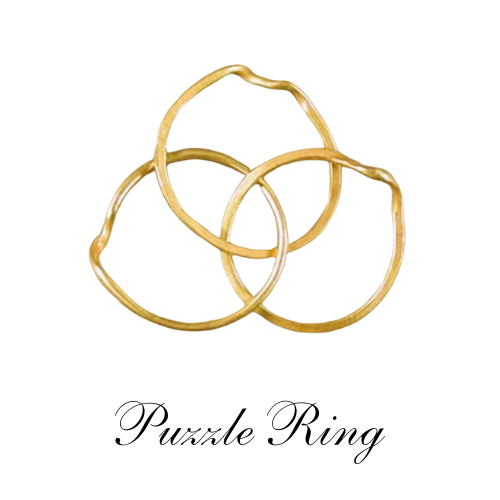 Puzzle rings are similar to gimmel rings. However, they usually have more bands. The bands can fit together in a specific way to form a single, cohesive ring.
Puzzle rings are similar to gimmel rings. However, they usually have more bands. The bands can fit together in a specific way to form a single, cohesive ring.
The primary use of puzzle rings historically has been twofold: as symbols of love and fidelity, and as an intriguing challenge. It’s said that they were given to wives in the Middle Ages to ensure faithfulness. If the ring was removed and disassembled, it would be challenging to put the bands back together without a specific solution, thereby revealing any infidelity. Today, they are often appreciated as interesting puzzles.
Although the origin of puzzle rings is somewhat mysterious, they are often associated with ancient Arabic and Turkish cultures. Over time, they gradually gain popularity in various cultures because of their beauty and the mental challenges they present.
In terms of design, puzzle rings can vary greatly. While traditional designs feature simple, intertwined bands, modern variations might include many intricate pieces.
Signet Rings
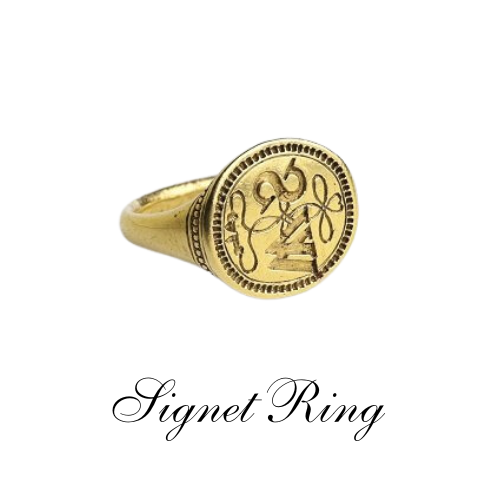 Originally serving a practical purpose, signet rings now symbolize family heritage and personal style. They are traditionally characterized by a flat bezel, often engraved with a family crest, monogram, or other symbolic imagery.
Originally serving a practical purpose, signet rings now symbolize family heritage and personal style. They are traditionally characterized by a flat bezel, often engraved with a family crest, monogram, or other symbolic imagery.
Historically, signet rings were used to seal documents and letters as a personal signature. The ring’s engraved design, typically a family crest or individual’s initials, was pressed into wax or soft clay to create a seal. This practice dates back to ancient civilizations, including the Egyptians, Romans, and Greeks.
Compared with the traditional signet rings, modern designs of these rings include a wide range of symbols, initials, or even abstract designs. The engraving on each signet ring is unique, often passed down through generations, making them a powerful symbol of lineage and family history. Additionally, the craftsmanship involved in creating these rings is a testament to their significance and the skill of the artisans who make them.
Thumb Rings
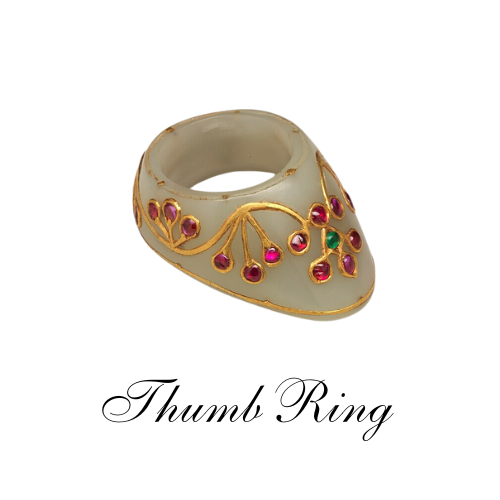 Thumb rings feature their distinct placement on the thumb rather than on other fingers. Originally, thumb rings had practical uses, particularly in archery, but over time they have evolved into fashionable accessories with various meanings and styles.
Thumb rings feature their distinct placement on the thumb rather than on other fingers. Originally, thumb rings had practical uses, particularly in archery, but over time they have evolved into fashionable accessories with various meanings and styles.
Historically, thumb rings have been used since the Neolithic period in Asia. Early thumb rings were made from materials like leather, wood, ivory, and rope. Later, metal thumb rings became more common. These rings were initially designed for archers to protect their thumbs during shooting. In cultures like ancient China, thumb rings were used to signify military ranks or seniority in religious sects. They also had protective connotations, believed to ward off evil spirits or misfortune.
The design and symbolism of thumb rings have varied throughout history and across cultures. In ancient societies like Greece and China, wearing a thumb ring was a symbol of power, rank, wealth, and influence. In Renaissance Europe, thumb rings were sometimes used to honor one’s spouse, with widows wearing their deceased husband’s wedding bands as thumb rings.
Today, thumb rings are often worn as a fashion statement, and their symbolism can vary. For men, wearing a thumb ring on the right thumb can represent wealth, power, and influence. For women, thumb rings can symbolize independence, freedom, and courage. Of course, there are also many people wearing thumb rings simply for aesthetic reasons, without any specific symbolic meaning.
Classification By Design or Style
Band Rings
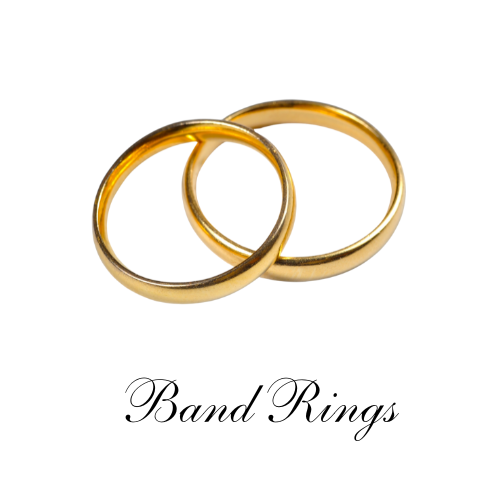 The defining feature of a band ring is its uniform width band without a distinct center stone or prominent setting that characterizes many other ring styles.
The defining feature of a band ring is its uniform width band without a distinct center stone or prominent setting that characterizes many other ring styles.
Band rings are most commonly associated with wedding rings. The circular shape, with no beginning or end, symbolizes eternal love and commitment. In many cultures, the wedding band is worn on the fourth finger of the left hand, based on the ancient Roman belief in the “vena amoris” or “vein of love,” which was thought to run directly from this finger to the heart. Over time, band rings have also become popular as fashion accessories, worn for their sleek and understated elegance.
The designs of band rings can vary, with some featuring plain, polished metal, while others include intricate patterns, textures, or engravings. They can be made from various metals, including gold, silver, platinum, and more contemporary materials like titanium or stainless steel.
Beaded Rings
 Beaded rings are crafted using small beads threaded onto a wire or string, forming various patterns and designs.
Beaded rings are crafted using small beads threaded onto a wire or string, forming various patterns and designs.
The art of creating beaded jewelry, including rings, dates back to prehistoric times. In the Paleolithic Age, beaded jewelry was made from organic materials like bones, shells, and stones. The use of beads evolved over time. In ancient Egypt, beaded jewelry held sentimental value and was often found in the tombs of kings and queens. Beads in these societies were made from precious stones like Lapis Lazuli, Carnelian, Turquoise, and quartz, crafted into elaborate designs. Native American and African tribes have also created beaded jewelry that can represent stories passed down through generations, marital status, and childbirth.
In contemporary times, beaded jewelry continues to be a popular form of handcrafted art. They can be customized in countless ways, using different types of beads and patterns to create unique and personalized jewelry pieces.
Bypass Rings
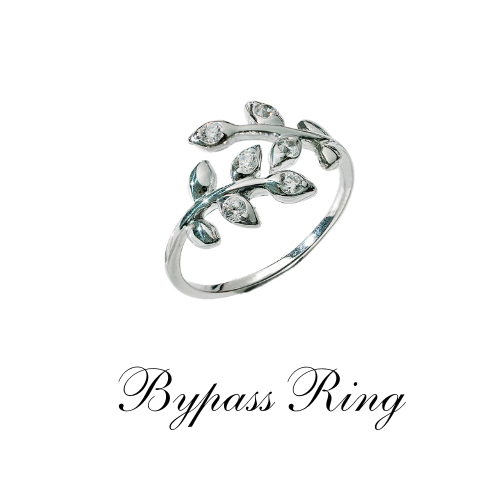 Bypass rings’ defining feature is a band that splits into two separate sections, often wrapping around the finger so that the ends pass each other on top. This swirling effect resembles two paths that cross or “bypass” each other.
Bypass rings’ defining feature is a band that splits into two separate sections, often wrapping around the finger so that the ends pass each other on top. This swirling effect resembles two paths that cross or “bypass” each other.
The history of the bypass ring design dates back to the Victorian era. A fascination with intricate and romantic jewelry designs characterized this period. With its beautiful curves, the bypass style became popular as a symbol of love and romance.
Bypass rings are commonly used for engagement and wedding rings due to their symbolic representation of two lives joining together. They are also favored as fashion jewelry because of their elegant and eye-catching appearance.
Cluster Rings
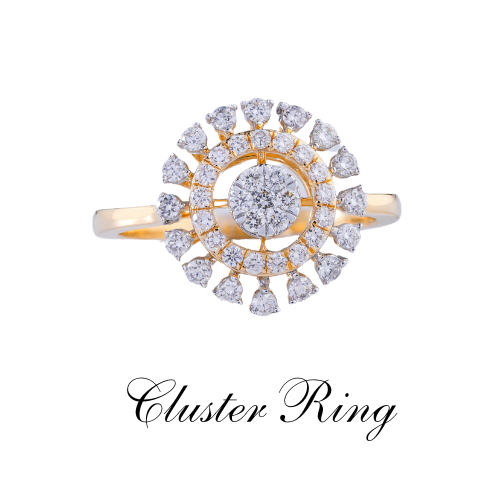 Cluster rings are a type of ring featured by a group of clustered gemstones. The clustered gemstones can form the shape of a central stone and make the little gemstones seem brighter and larger.
Cluster rings are a type of ring featured by a group of clustered gemstones. The clustered gemstones can form the shape of a central stone and make the little gemstones seem brighter and larger.
The history of cluster rings dates back to the Georgian era when they emerged as symbols of wealth and status. These early designs often resembled flowers, with intricate metalwork and gemstones set closely together. During the Victorian era, cluster rings evolved to include fun, whimsical, and romantic designs, often with floral patterns. The Industrial Revolution brought new methods and materials to jewelry making, leading to lighter designs and closer-set gems.
Today, cluster rings are often used for cocktail rings due to their luxurious appearance. Their symbolism has evolved over time, with different eras bringing their own interpretations. For instance, some cluster rings with a floral appearance may symbolize the beauty of life.
Dome Rings
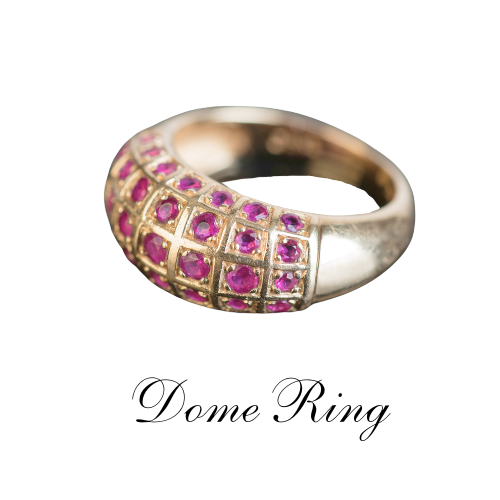 Dome rings are a stylish type of ring known for their bold appearance. They feature a curved, dome-shaped top that rises above the shank, giving them a three-dimensional look.
Dome rings are a stylish type of ring known for their bold appearance. They feature a curved, dome-shaped top that rises above the shank, giving them a three-dimensional look.
In the 1970s, dome rings gained popularity. They were often crafted in gold and sometimes adorned with gemstones like diamonds, emeralds, or turquoise. The dome itself can vary in height and curvature, allowing for a range of looks from subtle to striking.
Commonly, dome rings are used as fashion statements due to their eye-catching design. They suit various occasions, from casual outings to more formal events. The versatility makes them popular for those looking to make a bold style statement.
Eternity Rings
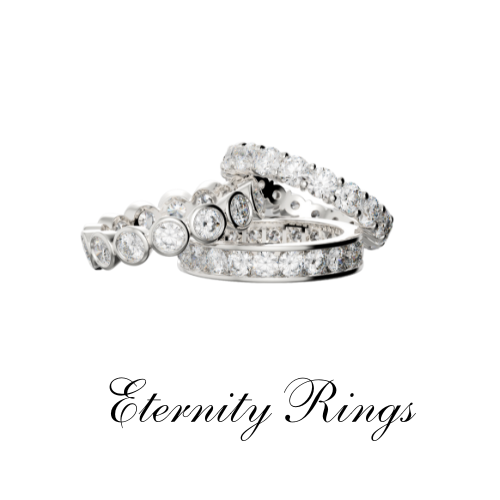 Eternity rings are a significant style within the types of rings. These rings are characterized by a continuous line of identically cut gemstones, usually diamonds, around the entire shank of the ring. This design symbolizes never-ending love and is often worn as a wedding band or given on special occasions such as anniversaries or the birth of a child.
Eternity rings are a significant style within the types of rings. These rings are characterized by a continuous line of identically cut gemstones, usually diamonds, around the entire shank of the ring. This design symbolizes never-ending love and is often worn as a wedding band or given on special occasions such as anniversaries or the birth of a child.
In the 18th century, eternity rings, known as a type of keeper ring, were synonymous with marriage. The introduction of diamonds to eternity rings is attributed to a marketing campaign by De Beers in the late 1940s, linking the precious diamond to the emotion of love.
Modern-day eternity rings come in two main types: full and half eternity rings. Full eternity rings have diamonds or gemstones set all the way around the band, whereas half eternity rings feature them set only partway around.
Filigree Rings
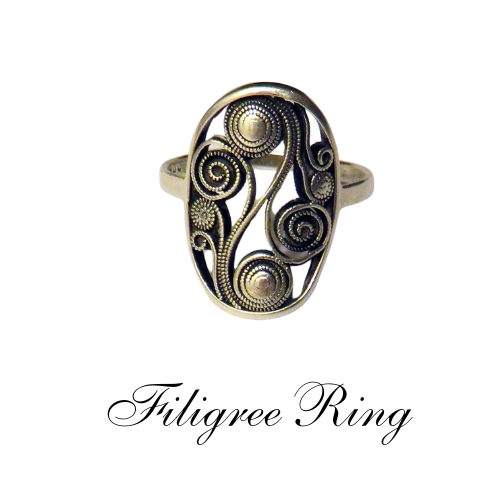 Filigree rings are delicate metalwork. The name ‘filigree’ comes from the Latin words “filum” meaning thread, and “granum” meaning grain. This design technique involves twisting thin metal strips, often gold or silver, into artistic motifs, creating a lace-like appearance.
Filigree rings are delicate metalwork. The name ‘filigree’ comes from the Latin words “filum” meaning thread, and “granum” meaning grain. This design technique involves twisting thin metal strips, often gold or silver, into artistic motifs, creating a lace-like appearance.
The history of filigree jewelry, including rings, dates back thousands of years, with early examples found in ancient Mesopotamia around 3,000 BC. The craft later spread to ancient Greece, where it signified social status. During the Edwardian period, filigree rings gained popularity in Europe, particularly with the use of platinum, which allowed for more detailed and intricate designs. The Art Deco period further popularized filigree rings with geometric patterns and the introduction of die-cast machinery, which made their production more feasible.
Filigree rings are often considered romantic and are typically used for engagement rings and other decorative jewelry pieces. Their delicate design can make a jewelry piece stand out even without gemstones. However, they can be challenging to maintain due to their complex designs and may require careful handling.
Gold Nugget Rings
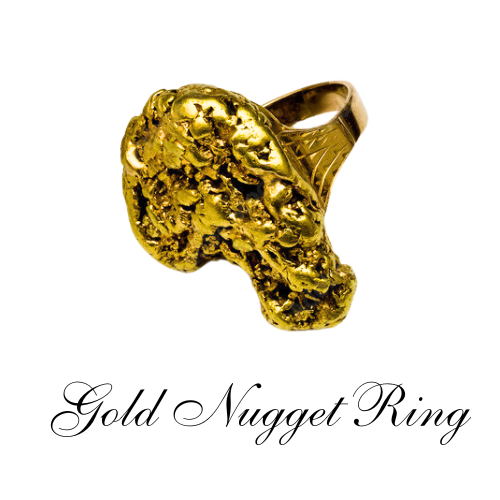 Gold nugget rings feature natural gold nuggets, often set in a band. Each gold nugget ring is unique, as the organic shapes and textures of the nuggets create one-of-a-kind pieces.
Gold nugget rings feature natural gold nuggets, often set in a band. Each gold nugget ring is unique, as the organic shapes and textures of the nuggets create one-of-a-kind pieces.
The history of gold nugget jewelry is closely linked to the Gold Rush era, particularly the California Gold Rush of 1848 and the Australian gold rush of 1851. During these times, prospectors flocked to these regions in search of gold. The discovery of gold nuggets ignited a frenzy that changed the landscape of the American West and Australia. Gold nugget jewelry, including rings, became symbols of wealth and power. Due to the rarity of actual nuggets, most were traded or melted down, and only a fraction became jewelry. In the 1980s, the fashion trend of “nugget” style jewelry became more popular, often using alloyed gold shaped into nugget-like forms.
Gold nugget rings are known for their rustic yet luxurious appeal. They can range from simple bands to intricate settings. These rings symbolize the allure of discovering treasure, thus appealing to those with a rustic and adventurous spirit.
Halo Rings
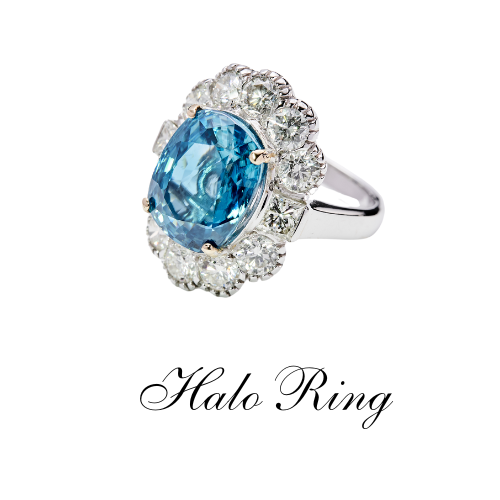 Halo rings are characterized by a central gemstone surrounded by smaller stones. Their design creates a “halo” effect around the main stone, enhancing its size and sparkle. This feature makes halo rings a sought-after style for engagement rings and other statement jewelry pieces.
Halo rings are characterized by a central gemstone surrounded by smaller stones. Their design creates a “halo” effect around the main stone, enhancing its size and sparkle. This feature makes halo rings a sought-after style for engagement rings and other statement jewelry pieces.
The history of halo rings can be traced back to the Georgian era when these rings first gained popularity. During this time, halo rings typically featured a round diamond or pearl as the center stone, with surrounding stones slightly smaller. This design created an opulent frame around the main stone. In the Victorian era, halo rings evolved to include large colored gemstones as the center stone, often surrounded by diamonds to mimic the appearance of a flower, as seen in Kate Middleton’s engagement ring.
The modern halo ring we commonly see emerged during the Art Deco era in the 1920s. This period favored clean geometric lines, symmetry, and bold designs, which perfectly aligned with the halo ring’s aesthetics. The Art Deco influence saw a more defined contrast between the center stone and the surrounding halo. The halo stones became smaller and more symmetrical.
Hololith Rings
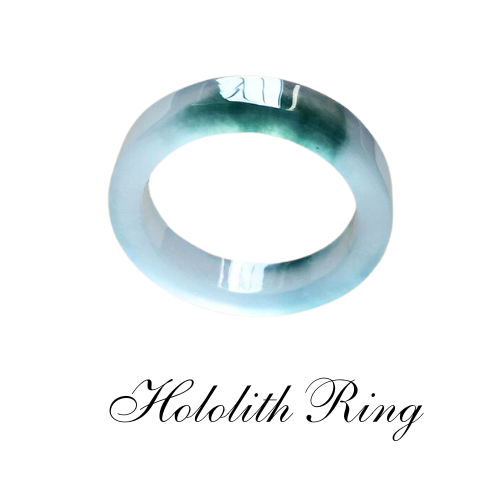 A hololith ring has a unique construction from only one solid mineral. Commonly crafted from jade or chalcedony, these rings maximize the natural beauty of stones. The seamless design of carving from one piece of stone offers a smooth and continuous appearance.
A hololith ring has a unique construction from only one solid mineral. Commonly crafted from jade or chalcedony, these rings maximize the natural beauty of stones. The seamless design of carving from one piece of stone offers a smooth and continuous appearance.
In different cultures, hololith rings have various meanings. Often, they are appreciated for their aesthetic appeal and the skill required to carve them from a single piece of stone. In some cultures, the type of stone used might carry specific significance. For example, jade is often associated with luck and protection in some Asian cultures.
The skill involved in creating a hololith ring is not just about the final product but also about understanding and respecting the material. Each piece of stone has its unique textures and colors. The artisan must work with these characteristics to bring out the stone’s natural beauty. It requires an artistic eye to make each hololith ring a unique piece of art.
Infinity Rings
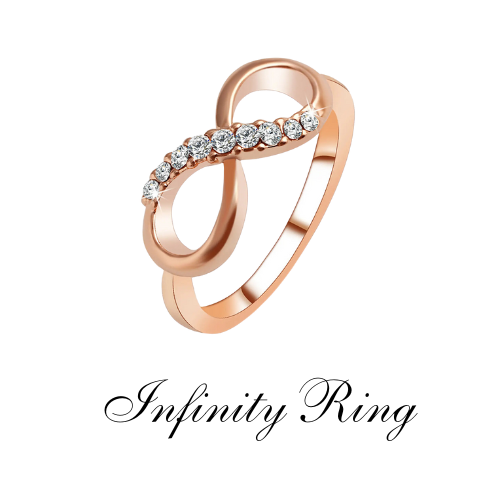 Infinity rings embody the concept of never-ending love and devotion. Their design often incorporates the infinity symbol as a knot or flat shape composed of gemstones on the ring.
Infinity rings embody the concept of never-ending love and devotion. Their design often incorporates the infinity symbol as a knot or flat shape composed of gemstones on the ring.
Historically, the infinity symbol, known as “lemniscate,” emerged from mathematical concepts but has since transcended into a broader representation of endless love and connections that surpass the test of time. In jewelry, infinity rings have evolved from simple forms to intricate designs incorporating colorful gemstones and diamonds.
Although the infinity rings sound similar to the eternity rings and they both symbolize enduring bonds, these two types of rings differ in their designs. The design of infinity rings must include the specific infinity symbol. However, eternity rings feature a continuous line of gemstones set around the entire circumference of the band.
Knot Rings
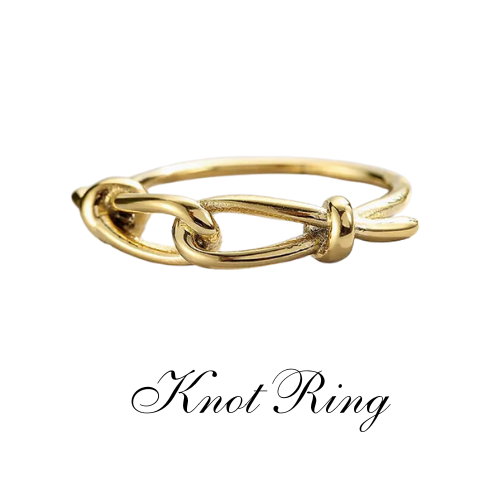 Knot rings are characterized by their overlapping designs, usually forming a continuous loop.
Knot rings are characterized by their overlapping designs, usually forming a continuous loop.
Historically, knot rings were used as symbols of protection and strength, particularly by sailors. In medieval times, they represented loyalty and allegiance. Knights would wear them as a sign of their devotion to their lords or their loves. The knot design was also believed to ward off evil spirits and bring good luck.
In modern times, knot rings are popular for their symbolic value. They are often used as alternative wedding bands, as they offer an affordable, meaningful option. They are also given as gifts to symbolize unbreakable bonds between friends or family members.
Besides, the meanings attributed to different knot designs can vary and are often interpreted differently. For example, the Trinity Knot, while commonly associated with the three stages of life (past, present, and future), can also symbolize the Holy Trinity in Christianity, the passages of time, never-ending love, and other concepts. Similarly, other knots like the Lover’s Knot, Celtic Knot, and Infinity Knot can have a range of meanings, often shaped by cultural, personal, or spiritual beliefs.
Midi Rings
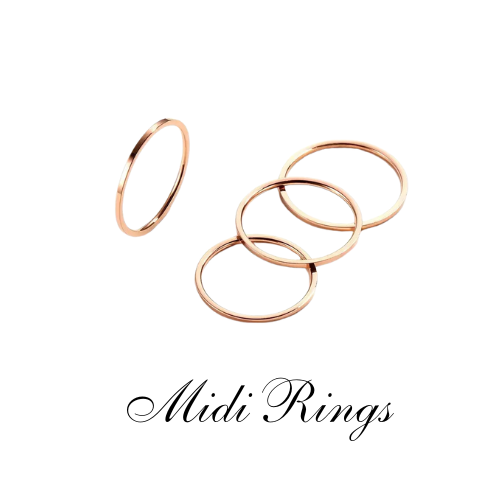 Midi rings, also known as knuckle rings, are a distinctive style of ring that sits midway between the tip of the finger and the first knuckle. They have become particularly popular in recent years.
Midi rings, also known as knuckle rings, are a distinctive style of ring that sits midway between the tip of the finger and the first knuckle. They have become particularly popular in recent years.
Midi rings differ from regular rings in their size and positioning on the finger. They are designed to fit snugly between the top two knuckles, which usually requires a smaller size than a regular ring worn at the base of the finger. Their history stretches back to the Renaissance era when wearing the midi ring was indicative of a lifestyle free from manual labor. As seen in Renaissance artworks, it was a symbol of wealth and privilege.
In modern fashion, midi rings have seen a resurgence among trendsetters. They are often worn in combination with traditional rings, either alone or in stacks, to create a stylish and unique hand accessory. The choice of wearing midi rings can vary based on personal style preferences, and they can be styled in many different ways to reflect individuality.
Mood Rings
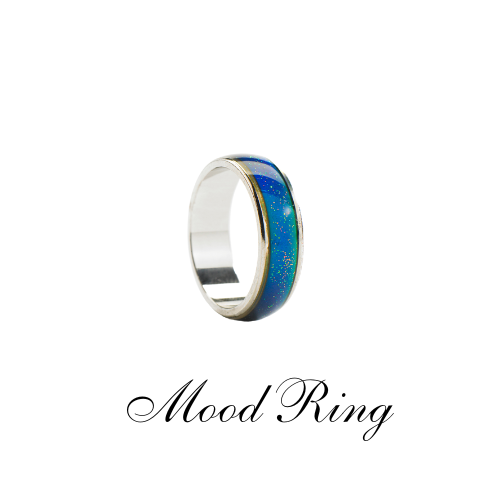 Mood rings are a type of ring that became popular in the 1970s. They consist of a thermochromic element, often called a “mood stone,” which changes color based on the temperature of the wearer’s finger. The theory behind mood rings is that these color changes correspond to the wearer’s emotional state because emotions can influence body temperature.
Mood rings are a type of ring that became popular in the 1970s. They consist of a thermochromic element, often called a “mood stone,” which changes color based on the temperature of the wearer’s finger. The theory behind mood rings is that these color changes correspond to the wearer’s emotional state because emotions can influence body temperature.
The concept of mood rings was first developed in 1975 by Joshua Reynolds, a marketing executive from New York City. He was intrigued by the idea of using thermosensitive elements in jewelry, inspired by liquid crystal elements used in medical thermometers. Reynolds and other jewelers like Marvin Wernick, who created mood rings before Reynolds but called them “magical,” capitalized on this idea and started a significant fashion trend.
Despite their initial popularity, mood rings were somewhat short-lived as a fashion craze, mainly due to the limited lifespan of the heat-sensitive crystals. These crystals would only emit color changes for about two years and then permanently turn into a shade of black. However, mood rings saw a resurgence in the 1990s. They have since been updated with better-sealed liquid crystals and improved longevity.
Today, mood rings are often seen as fun, novelty items rather than accurate indicators of mood.
Open Rings
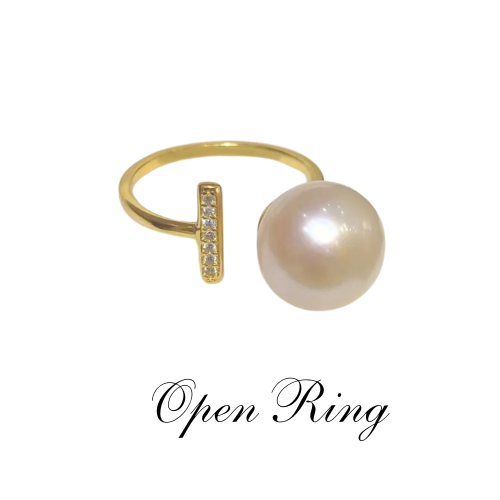 Open rings are a type of ring that features a gap or opening in the band. The most common shape for open rings is one where the two sides of the ring’s shank do not connect, leaving a gap that is often embellished between the two ends.
Open rings are a type of ring that features a gap or opening in the band. The most common shape for open rings is one where the two sides of the ring’s shank do not connect, leaving a gap that is often embellished between the two ends.
Open rings can be traced back to when Celtic knotwork designs incorporated open spaces mixed with intertwining patterns in their ring designs. The modern interpretation of open rings includes various styles, some with openings in the shoulders, and some have hollow designs, which can make them more affordable.
These rings are versatile in their use and symbolism. They can be part of a wedding ring set, worn alongside fashion rings, or as part of a set of stacking rings. Their designs make them fashionable for daily wear and special occasions. Many open ring styles can be adjusted, therefore allowing for a comfortable fit for a wide range of ring sizes.
Semi-Mount Rings
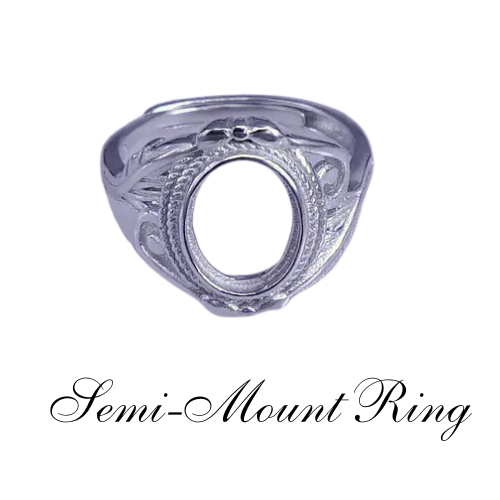 Semi-mount rings are a unique and customizable type of ring setting. A semi-mount ring is essentially a ring that has been partially completed – it includes the band, side stones, and other possible intricate designs, but lacks a center stone. The buyer can choose a preferred gemstone to complete the ring.
Semi-mount rings are a unique and customizable type of ring setting. A semi-mount ring is essentially a ring that has been partially completed – it includes the band, side stones, and other possible intricate designs, but lacks a center stone. The buyer can choose a preferred gemstone to complete the ring.
The concept of semi-mount rings has been around for quite some time. And it has gained more popularity in recent years due to the growing interest in custom jewelry. These rings offer the flexibility to select a center stone that fits one’s budget, style, or sentimental value. It could be a family heirloom diamond, a newly purchased gemstone, or a unique stone of particular significance.
The ready-made settings of semi-mount rings often include various designs like halos, side stones, intricate metalwork, or pavé settings. The central area is left empty, intended to be filled with a stone of the buyer’s choosing.
Solitaire Rings
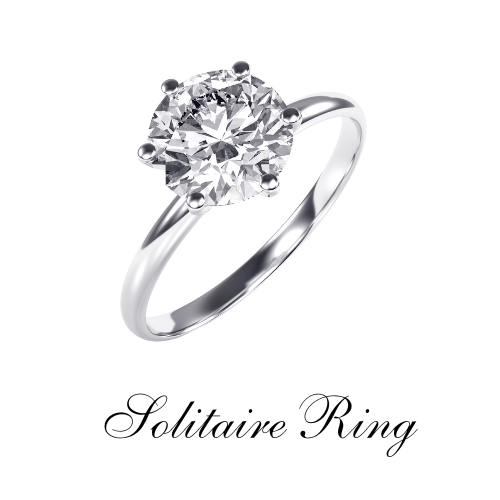 Solitaire rings are iconic in the world of rings and are often seen as engagement rings. Their defining feature is a single, prominent gemstone, typically a diamond, set on a simple metal shank. This design allows the gemstone to take center stage, emphasizing its beauty and brilliance.
Solitaire rings are iconic in the world of rings and are often seen as engagement rings. Their defining feature is a single, prominent gemstone, typically a diamond, set on a simple metal shank. This design allows the gemstone to take center stage, emphasizing its beauty and brilliance.
The first recorded diamond solitaire engagement ring was given in 1477 by Archduke Maximilian of Austria to Mary of Burgundy. This event marked the beginning of the diamond’s association with engagement rings. The tradition of the solitaire ring evolved further with the discovery of platinum in the early 1700s. Platinum, with its durability and natural white luster, became a popular material for these rings, enhancing the brilliance of the diamond.
Today, various settings have been developed to showcase the solitaire diamond, including prong, bezel, and tension settings, each offering a different aesthetic and level of security for the stone.
Spinner Rings
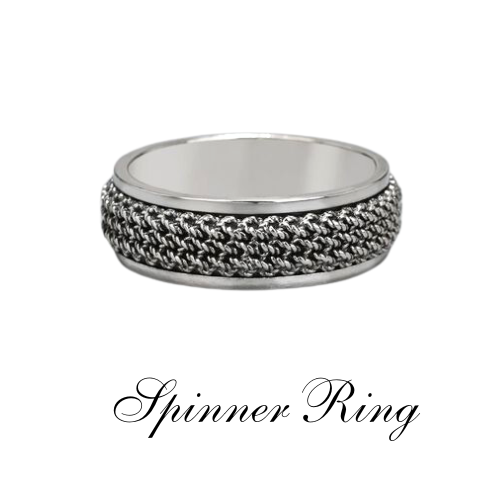 Spinner rings, also known as worry rings or fidget rings, have a rich history and a special place among types of rings. Originating from ancient Tibetan meditation traditions, spinner rings were initially used to calm the mind during meditation. They featured an outer band, often inscribed with sacred text, that spun around a stationary inner band. This spinning motion was believed to help focus the mind, increase good karma, and eliminate any bad energy during religious practices.
Spinner rings, also known as worry rings or fidget rings, have a rich history and a special place among types of rings. Originating from ancient Tibetan meditation traditions, spinner rings were initially used to calm the mind during meditation. They featured an outer band, often inscribed with sacred text, that spun around a stationary inner band. This spinning motion was believed to help focus the mind, increase good karma, and eliminate any bad energy during religious practices.
Today, spinner rings are valued for their therapeutic benefits. The repetitive motion of spinning the ring is found to help alleviate anxiety and stress. While they may not possess any mystical powers, the act of spinning can help bring the wearer into the present moment, acknowledging and managing feelings of anxiety.
Spinner rings are commonly used for anxiety relief and are popular among people who benefit from fidgeting to focus or calm their nerves. They can also serve as stylish jewelry with a personal significance to the wearer.
Three-Stone Rings
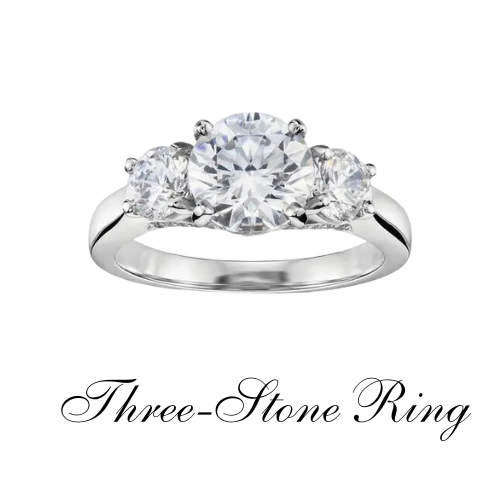 Three-stone rings are a type of ring with three gemstones set in a row on the ring’s band. The central stone is typically larger and flanked by two smaller stones.
Three-stone rings are a type of ring with three gemstones set in a row on the ring’s band. The central stone is typically larger and flanked by two smaller stones.
The three stones in a three-stone ring each carry significant symbolism, often representing the past, present, and future. The first stone symbolizes the couple’s past and their journey together, the central stone represents their current love and commitment, and the third stone signifies the future and all it holds. This symbolism makes three-stone rings particularly meaningful for engagements, anniversaries, and other relationship milestones.
The concept of three-stone rings dates back centuries, with their popularity gaining momentum during the Victorian era. Modern three-stone rings are versatile in design. They can feature various gemstones, including diamonds, sapphires, and rubies.
Wire Rings
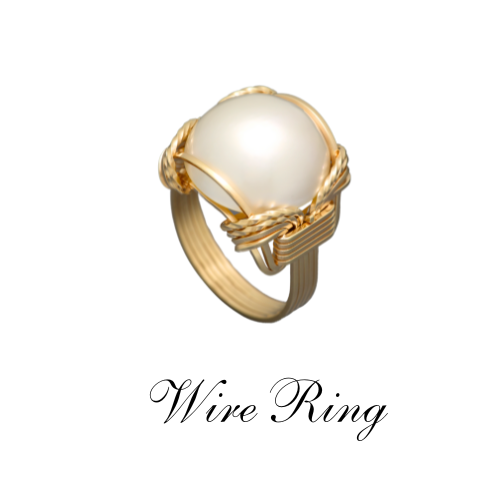 Wire rings are crafted using thin metal wire, often shaped into intricate designs. This technique, known as wire wrapping, involves creating jewelry by bending, twisting, and looping wire.
Wire rings are crafted using thin metal wire, often shaped into intricate designs. This technique, known as wire wrapping, involves creating jewelry by bending, twisting, and looping wire.
Wire rings date back to ancient cultures, including the Egyptians, Greeks, and Celts. These cultures used simple tools to shape and manipulate metals into intricate patterns. The wire wrapping technique has evolved over time, with modern wire rings showcasing various styles, from simple loops to complex, intertwined patterns.
Wire rings are often flexible in design. The wire can be manipulated into various shapes and sizes, allowing for a range of styles from minimalist to elaborate. These rings can also incorporate gemstones, beads, or other decorative elements, adding to their aesthetic appeal.
Sometimes, people may mistake wire rings as filigree rings. Although they both use metal to create intricate patterns, wire rings differ from filigree rings. Filigree involves soldering tiny metal beads or twisted threads to the ring shank, whereas wire rings are created by bending and wrapping the wire itself (the wire is the shank).
Final Words
As we wrap up our exploration of the 43 different types of rings, we hope you found this journey enlightening and enjoyable. We understand that the world of rings is vast and varied. Your opinions and questions are always welcome. So, if there’s a particular type of ring that caught your attention, a style you’re curious about, or any other ring-related thoughts you’d like to share, please feel free to comment. We are always here to exchange brilliant thoughts!
If you are going to shop for rings, here are some other tools that may be helpful → [US Ring Size Calculator] [Japan Ring Size to US Ring Size Converter].



